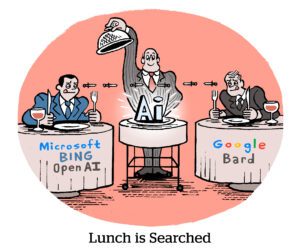Alphabet executives spent the company’s Q1 earnings call on Thursday evening hyping AI and dodging questions about the landmark antitrust ruling against Google last week, declaring it an illegal monopolist in the online advertising market.
Just kidding.
Neither the ad tech antitrust case against Google nor the search antitrust case – a hearing over remedies in the latter is currently underway – were addressed during the call. The leadership didn’t bring them up, and there wasn’t a single investor question.
We sheesh you not.
Also unmentioned: Google’s wholesale reversal on third-party cookies in Chrome just days ago, which caused emotional meltdowns across the entire industry.
Instead, AI took center stage, despite not being a major driver of revenue – yet.
Alphabet’s revenue topped $90 billion during the first quarter, $34.5 billion of which was net income, a 46% YOY increase.
The Google ad network business did tick down by $157 million year over year, but it’s already been on a steady decline for the past couple of years. And that small loss in ads served across the web was more than made up for by multibillion-dollar gains apiece for Google Search, Google Cloud and Google’s subscription and device segment.
The AI overview
Google’s AI Overviews (AIOs), which are the generative responses that show atop many traditional search queries, now count 1.5 billion users per month, said CEO Sundar Pichai.
It’s not clear, however, exactly what that number means. Pichai later noted that these AIOs users are “interacting with AI in a deep way, a very engaged way,” which implies “1.5 billion” is the number of users clicking or interacting with those responses, rather than just being exposed to them.
Regardless, it’s a big number. And AIOs aren’t Google’s only AI-driven venture.
“All 15 of our products with half of a billion users now use Gemini models,” Pichai told investors. And other Google products, such as Google’s tablet devices, headphones, watches and tech for cars, are in the process of “upgrading” to Gemini, as Pichai put it.
AIOs monetize at “approximately the same rate” as traditional search query responses, according to Google’s chief business officer, Philipp Schindler, which “gives us a strong base on which we can innovate even more.”
Google’s reported AI usage and monetization remains puzzling, though. JP Morgan internet equity analyst Doug Anmuth, for example, asked “how we should think about” the 1.5 billion AIOs users. He received no clarity on what the metric conveys.
Anmuth then pressed Schindler for more information on AIOs monetization. “I know you’re saying monetization at approximately the same rate,” Anmuth said, “but what does that mean in terms of click-through rates and conversion?”
Schindler would only reiterate that AIOs ad placements monetize at approximately the same rate as traditional search. “I don’t think this is the moment to go into the details of click-through rates and conversion and so on,” he said.
Google’s infants
But although AI is still a (relative) baby, many of Google’s products have now reached adulthood. Google Search celebrated its 25th anniversary two years ago, Gmail’s 20th was last year, and, on the call Thursday, Pichai mentioned that YouTube’s first-ever video was uploaded almost exactly 20 years ago.
The maturity of these products, many of which began with uncertain monetization and may have seemed like cost centers long ago, are a proof point for Google’s portfolio of new products and services, which are just reaching toddlerhood.
AIOs, for example, are one year old. Pichai and other Google leaders noted that fact numerous times during the call.
And then there’s “Circle to Search,” a feature on Android devices that lets people search for anything that’s visible on the screen. It only launched last year, and visual searches have already increased by 5 billion since October, Pichai said.
Not to mention Waymo, Google’s autonomous driving division, which began delivering paid rideshare pickups in Q4 2024 and is now at a quarter-million rides per week.
And it’s not hard for Wall Street to accept Google’s investments in these businesses now, considering Google’s profitability and profit margin are at record highs for Google’s Services (which includes ads) and Cloud segments, as noted by Evercore analyst Mark Mahaney, who also asked about Waymo’s long-term monetization plans.
“This is probably the first question I’ve gotten on our earnings on Waymo, so thank you,” Pichai responded to Mahaney.
Waymo, Pichai said, isn’t yet committing to a particular revenue approach.
From Google’s perspective, investors should consider its 20-year-old services, take a deep breath and ask us about Waymo and AIOs revenue again in a decade or so.


















